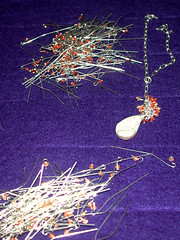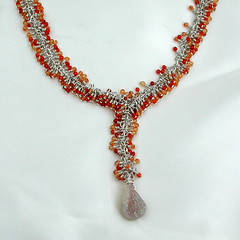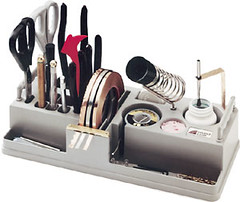I won’t tell you individually whether or not you are pricing your items correctly, but here’s a few things to take into account when you’re deciding how much to sell your items for.
1) Cost of materials.
Do you actually track this? Do you know how much you’re spending in components for each piece? This is your first step. I found Excel to be good for this. A strand of beads for $$$, and xx beads in the strand, entered into a table to do the math for you. Wire? How much per ounce, how many feet per ounce, and how much wire goes into one necklace? Do the same for chain, tigertail, silk cord, or any of your other materials. Once you’ve totaled all this up, you want to figure in your margin. Standard is multiply the total by 2-3 times, usually. If you double cost of expenses, see item #3. If you triple, #3 is probably unnecessary.


2) Labor hours
How much are you paying yourself to make your work? You do pay yourself, don’t you? I hope so. I’m sure if this is part time for you and you have another job, and that you aren’t working for them for free! At the absolute least, you should be paying yourself minimum wage per hour for the time you put into making a piece. If it’s very physically or mentally demanding, a higher wage is warranted. It’s the same as any other job. Starting out, you begin at the bottom of the payscale, but as your experience & skills increase, so should your paycheck. This takes into account the hours of practice you’ve put in, and any classes you may have taken to further your skillset. An experienced seamstress or metalsmith can easily rate themselves at $20-30/hour, or more.

3) Incidental expenses
How much time do you spend going to the post office? Or the supply stores? How much did it cost you to get set up with all the equipment you need to function as a business, and is there more equipment you need to buy, or a class you would like to take to improve your skills or learn new techniques? How much do you have invested in your workspace, for tables, lamps, etc. How much of your home electricity bill goes into heating and lighting this workspace? And have you taken into account the wear and tear on your equipment and your vehicle, and the fact that at some point you will have to do maintenance or repair on it, or replace it when it wears out? This is what keeps you afloat as a business, allowing you to expand your stock and improve your skills and production methods.




You may think initially it’s better to start out with lower prices, and raise them as you become more successful, but if you start out underpricing yourself too much, you’ll put yourself out of business before you have a chance to become a success.
And another little wrinkle to throw at you – perception can affect people’s opinion of the quality of your wares. When I started out at a local weekly craft fair, about 10 years ago, I was getting pretty depressed after my first month, with lots of work and little to show for it. Another vendor, who’d been my neighbor the whole month, took me aside as we were breaking down one Sunday to tell me, “Your prices are too low – people won’t believe it’s real silver and pearls and stones in your jewelry because of it. Before you come back next week, mark up all your prices by $5/piece.” I was skeptical, but I gave it a go, because what I’d been doing hadn’t been working after all. And the next week, I sold six necklaces! Jewelry was only a sideline for me at that point, but that day I sold more jewelry than my main line of wares. If you underprice yourself too much, the same thing can happen to you, and you’ll be adversely affecting your chance of success.
Hopefully this gave you a few things to think about. Miss Nellie and The Skitter Kitty are wishing you and yours a Merry Christmas!








10 comments:
oh you love your kitties like we love ours .. we have 3 big heafty ones,,, smiles mar
this is such useful advice! thanks.
These are some good things to remember and help us make sure we're pricing ourselves right and not going out of business before we go into business. :)
That piece at the top looks like it has hours and hours of labor in it.
I just finished doing a piece with little tiny bead wraps like that and each time I do I tell myself I'll never do that again, but then later I get an idea for something with lots of dangles or fringe and I start getting into it. The look of bushiness is really pretty! Those are the hardest ones to sell though.
Giftbearer - I agree, I love doing them, and they sit and sit, but they are great eye-catchers, and so much fun to do! I think it's always good to have a few of these types of pieces, to showcase your capabilities.
Great post! I think it's true that a lot of people underprice...just because it's handmade doesn't mean it was cheap to make...which is what I think that a lot of "new" crafters might think that buyers are thinking.
And Oh my gosh, your black and white kitty looks like our black and white, in reverse! :)
great post! It is something I think we all struggle with at some point!
These are great points. Somehow seeing them in print causes more thought. Thank you, and you too have a wonderful new and happy 2009.
Great blog!
Hope your holidays are going well!
I'm constantly amazed by how low people will go with their handmade stuff. Pricing was the hardest part for me... but using a formula like this one helped. Thanks!
Post a Comment